Several years ago I was preparing to hunt elk with my Native American friend, Joe Two Ponies, out on a ranch near Wapiti, Colorado.
We were at the ranch’s shooting bench, and two hunters had just made certain their rifles were properly sighted. I waited until they had finished before pulling out my T/C Encore handgun chambered in .30-06. Seated at the bench, I broke open the action, inserted a 165-grain SST Hornady round into the barrel, then settled into a comfortable shooting position behind the long-eye relief scope.
As I reached to cock the hammer, one of the hunters standing beside me muttered, “Dollar says he won’t even hit the 100-yard target!”
I shifted to settle the crosshairs on the 200-yard target, cocked the hammer, let out all my breath and started squeezing the trigger. Following through after the shot, I felt assured that I had not only hit the 200-yard target, but I was pretty sure that I’d scored a bullseye.

Then: “There’s no sign of a bullet hitting the hundred- yard target,” cowed the snickering hunter.
And my response: “Sir, you might want to look at the 200-yard target,” I said, as I broke open the Encore to prepare to load another Hornady round. Then I added, “Ohhhh…You wanted me to shoot at the 100-yard target!”
As I settled in on the 100-yard target, I heard Joe Two Ponies say, “Guys, there’s one hole in the 200-yard target in the bullseye. There were no shots in that target until he shot!”
I acted as if I did not hear him, then shot at the 100-yard target. I quickly reloaded and shot again at the same target. The two shots touched a half-inch above the bullseye. That’s when the guide cleared his throat, admitting, “Maybe I misspoke earlier!” I simply grinned.
“Gentlemen,” I continued. “Shooting a handgun is no different than shooting a rifle. The bullet goes where the barrel is pointed when the trigger is pulled!” With that, I holstered my handgun and declared, “I think I’m ready!”
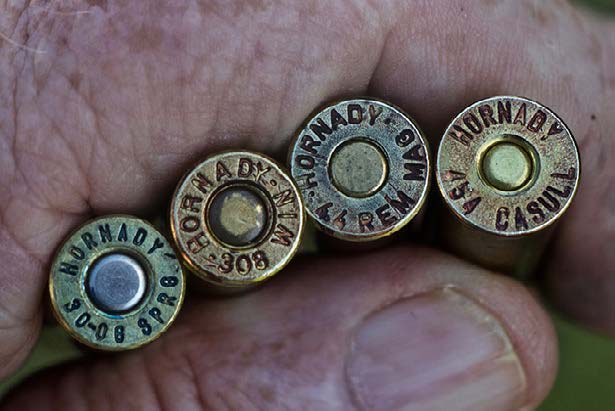
Two Earlier Elk Hunts
When that took place I had already been on two other elk hunts. One was in far Western Texas, where I had taken a very nice 7×7. That animal was shot at 75-yards with my .30-06 handgun/Hornady ammo combination. When I hit him immediately behind the shoulder, the bugling bull stood statue-still just long enough for me to quickly reload and shoot him a second time before he crumpled to the ground.
A few days after that hunt, I headed to Colorado to hunt a huge high-fence property for elk. After passing up numerous bulls of most interesting stature, my two guides and I spotted a wide 7×7 on a distant ridge.
The stalk was a long one that included belly-crawling past two other bulls with small herds of cows. Thankfully, there was sufficient oak so we could wiggle like snakes to get past those elk. We cut the distance to 150 yards, ending up on top of a boulder overlooking the valley below us. Our stands were just beyond the grassy park between two oak mottes. I felt comfortable taking the shot from there.
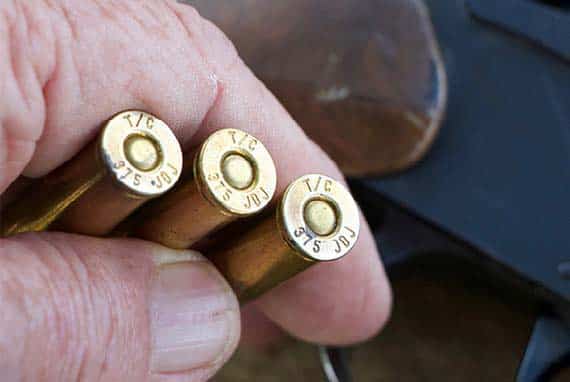
The shot reminded me of the first bull elk I had taken with a handgun, the year I introduced the T/C Encore to the world in the pages of Shooting Times magazine, where I served as the hunting editor. That elk hunt occurred a week after I took the first animal taken with a T/C Encore (at the time we were not certain what the gun would be named). It was a moose in Maine. That particular handgun was chambered in .308 Win, shooting Hornady 180-grain soft point ammo.
The shot at that first handgun elk was about the same distance and in very similar terrain and habitat as what laid before me now. Back then, at the shot that 6×6 simply crumpled to the ground. I hoped this 7×7 would do the same.
Resting my handgun on my backpack, I cocked the hammer and took several deep breaths. When the crosshairs settled immediately behind the bull’s shoulder, I squeezed the trigger. At the shot, the bull bolted 50 yards and then stopped with legs locked! That gave me time to reload and ready a second shot. This time, I held to hit him in the spine or very close to it. I pulled the trigger. As the handgun recoiled, I saw the bull drop. I reloaded and kept crosshairs on him; he didn’t move. At his side, I could not believe how big he was of body and antler. Later at the skinning shed, I opened him up. My first bullet had gone through his on-side lung, through the top of his heart, through the off-side lung. It had broken a rib on the opposite side and was lodged just under the skin.
It had been a pretty good start to that particular elk year: two 7x7s already in the salt.
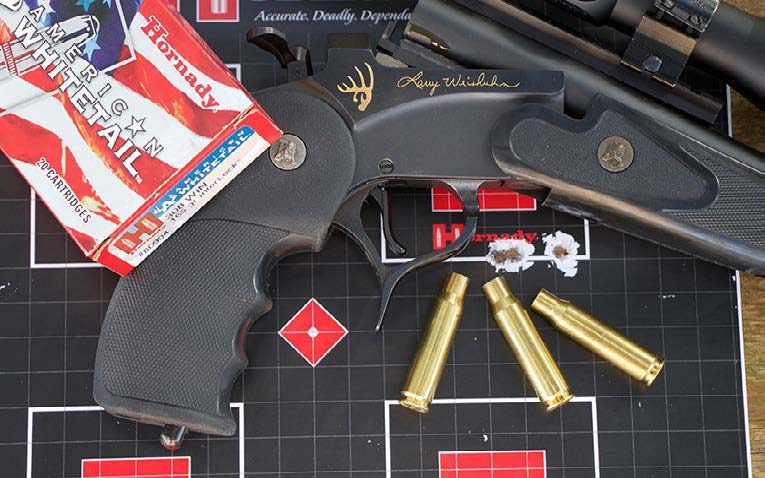
Back to the Ranch
So, back to hunting with Joe Two Ponies…
Hunting the western side of the spacious ranch, we spotted a unique 7×7 bull. His antlers looked almost like those of a red stag, including palmation. We took advantage of a scattering of junipers and oaks to cut the distance to 250 yards. But then there was no way to get any closer. I decided to shoot from there.
I loaded a Hornady round into the .30-06 Encore, got into a prone position using my backpack as a rest, cocked the hammer and settled the crosshairs about a quarter of the way down from the bull’s back, immediately behind his broadside shoulder. I shot. The bull shuddered and took a few steps to his left. I quickly hit him a second time. The bull shook as if trying to rid his coat of rain. While he was doing that I reloaded and got on target, this time moving forward a bit into his shoulder. I shot and the bull fell to the ground.
Once at his side and admiring his antlers, we noticed he was missing his front right foot. The leg was healed over as if his injury had happened years ago.
I grabbed Two Ponies’ congratulatory hand. Then, the realization set in. I had taken three 7×7 bull elk during the same fall. All three were taken with my .30-06 T/C Encore handgun using Hornady ammo.
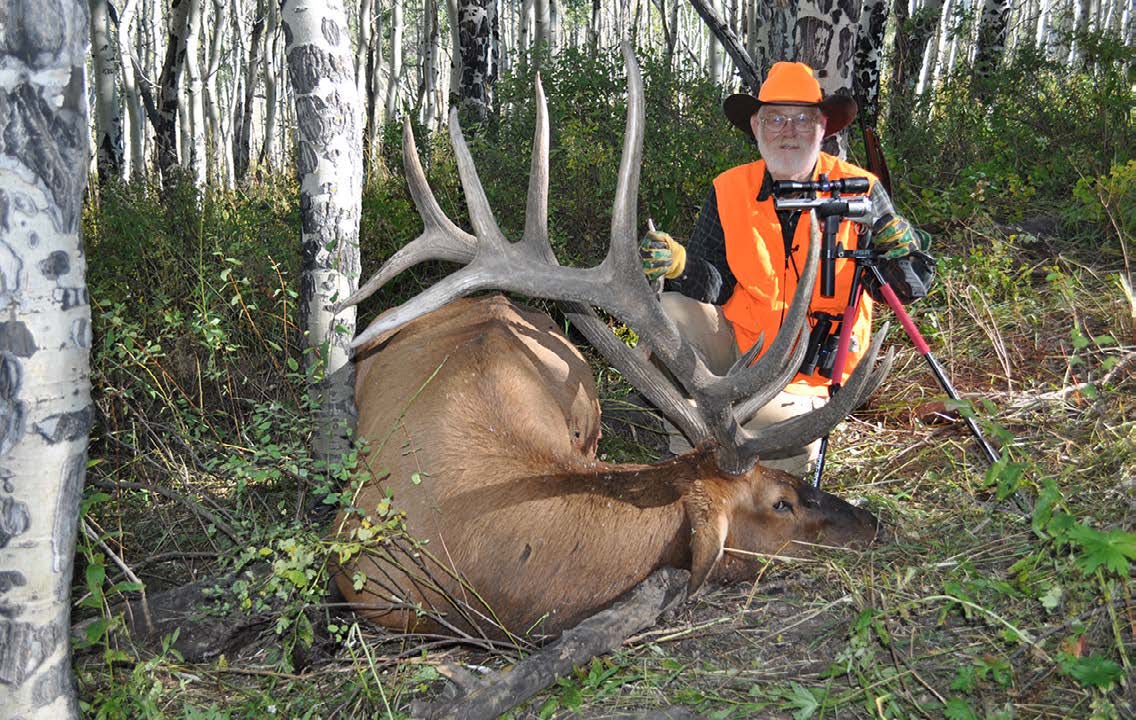
A Great Invitation
Five years later, I got a call from an outfitter friend of mine, telling me, “You need to come hunt elk with us this year, and bring your handgun. I think we can find you a pretty decent bull!”
I love such invitations! I could not say “Yes!” fast enough!
My handgun of choice this time was a Ruger Super Blackhawk Hunter chambered in .44 Mag, topped with a prototype Zeiss long-eye relief scope, shooting Hornady 240-grain XTP ammo. I spent a fair amount of time at the range before leaving for the hunt, shooting from various rests. I learned many years ago that I shoot considerably more accurately from a good rest than by shooting off- hand. My tripod rest was a Bog-Pod, then owned by Kim Hicks. I had helped him develop the tripod shooting sticks and the handgun rest I used on the hunt. Kim later sold his equipment company, and unfortunately, the new owners discontinued the best handgun rest ever developed. Thankfully, I saved one. From that rest, I can put all six shots from my hunting revolvers into less than two-inch circles at 100 yards.
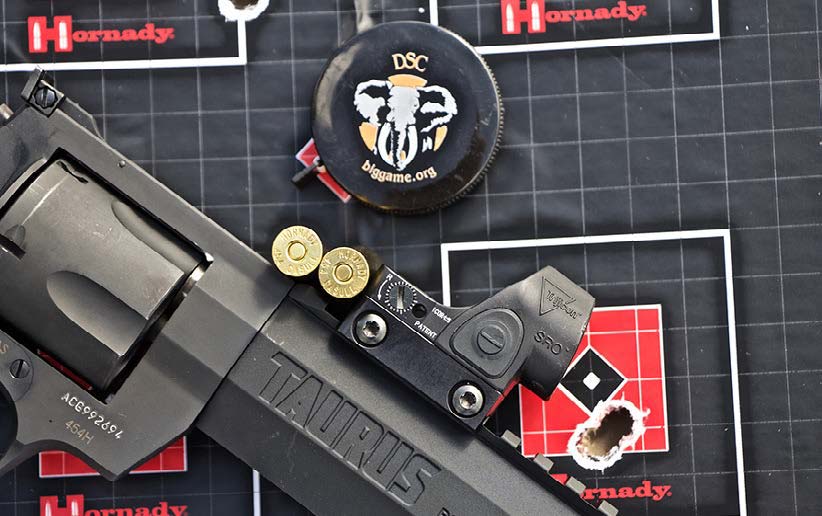
Thinking Back
At the time of my hunt, the elk were still bugling. That is how we located my bull. He had a deep, gruff bugle. He sounded old and big!
We found him in an aspen thicket, along with a younger bull. “He” was an old, massive, long-tined 6×6 approaching, and if you are interested in scores, he was 370 to 380 B&C. In other words, huge!
The wind was ideal to get us to within 125 yards. But from what we could see of leaves moving, trying to get any closer without the two bulls catching our scent would be “iffy.” I was happy with the distance. If knew I could place bullets into the vitals at that distance. And I felt assured there would be sufficient down-range energy to do serious damage to the bull’s lungs and heart.
Solidly on the Bog Pod handgun rest, elbows braced against aspen trees, it was almost like shooting from a bench. I cocked the hammer. Four accentuated heartbeats later, I pulled the trigger. The bull did not react. I immediately cocked the hammer and got a good sight picture about six inches from where I had placed the first shot. I pulled the trigger again. The bull seemed unaffected, although the younger bull ran after my first shot. My bull was still standing. I again cocked the hammer and moved the crosshairs another four to six inches from my last two shots and squeezed the trigger. I heard my guide say, “You hit him again!”
My purpose of placing my shot four-to-six inches apart was to create three separate wound channels rather than shooting him in the same place (and not creating additional wound channels). That’s something to remember, regardless of whether you use bullet or arrow to hunt. I prepared to shoot a fourth time. Then, the bull fell! I watched where he had fallen. If he tried to get up, I was going to shoot him again. But, he did not.

The Biggest Ever
At his side, my knees got a bit weak. He was huge of body and antlers, and easily the big- gest-bodied and antlered bull elk I had ever taken—and, likely will ever take. After photos, I gutted him. I found two spent bullets just under the skin on the opposite side. The third had ex- ited! Hornady’s 240-grain XTP bullets had literally destroyed both lungs and heart.
Over the years I have taken other elk with my single- shot and hunting revolvers, including some other very impressively antlered bulls. I truly enjoy hunting elk with a handgun!
Hunting elk with a handgun is no different than hunting elk with anything else, although you have to know your limitations in terms of distance in taking the shot. One question to consider is how accurately can you place a bullet at varying distances. The second question is whether there is sufficient downrange energy to do considerable damage to vital tissues, and at what range does that become a limiting factor? Remember, elk can be extremely tough and tenacious.
When I was hunting elk with break-open handguns I primarily used two rounds, .308 Win and .30-06. The .308 Win utilized all the powder in the case in about a 15-inch barrel. My .30-06, which I dearly loved and used on a wide variety of big game animals, had a shortened barrel with the ballistics of a .308 Win. Beyond elk, I also successfully used both those rounds on moose hunts from Alaska to Maine to Wyoming to Colorado.
When it came to hunting revolvers back then, as today, my choice was primarily the .44 Mag, although other good choices were and still are .454 Casull, .460 S&W Mag, .480 Ruger and .500 S&W Mag regarding commercially available rounds.
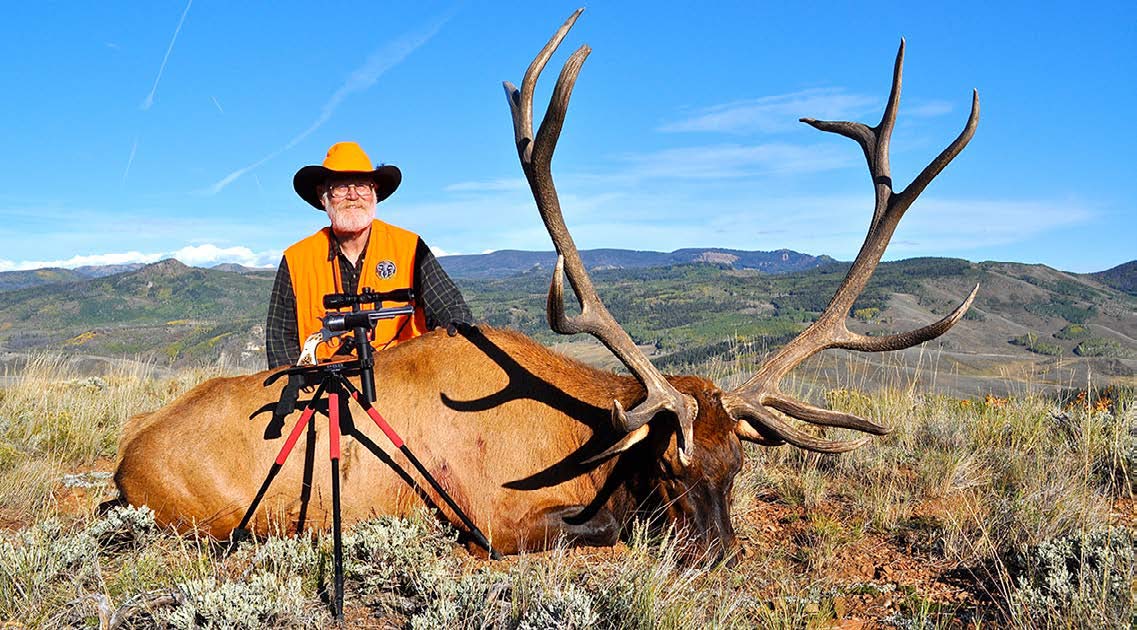
I am personally not a big fan of semi-auto pistols when it comes to hunting handguns. I prefer revolvers and single- shots. Unfortunately, it has been a while since I have had the opportunity to hunt elk with a handgun. But I again have the “want to” to do so. Rather than hunting a bull, this time I intend to take a cow. I dearly love elk venison! My family does as well. Actually, it was they who suggested I hunt elk again.
My elk hunting rig this “go-round” will be my .454 Casull Taurus Raging Hunter, double action hunting revolver, topped with a Trijicon SRO 2.5 MOA red dot sight, and shooting Hornady’s 300-grain XTP loads. It’s the same combination I am using on other hunts this fall—and I’m planning many! Shooting from a solid rest I can place 6 six shots into less than a two-inch circle at 100 yards, several touching. That said, remember that at 100-yards, a 2.5 MOA red dot covers two and a half inches at that distance. The .454 Casull, Hornady round maintains sufficient downrange energy to quickly and humanely put down an elk out to 125 yards, and actually farther.
Thinking about it now, I can almost taste those delicious elk steaks!
Per our affiliate disclosure, we may earn revenue from the products available on this page. To learn more about how we test gear, click here.



